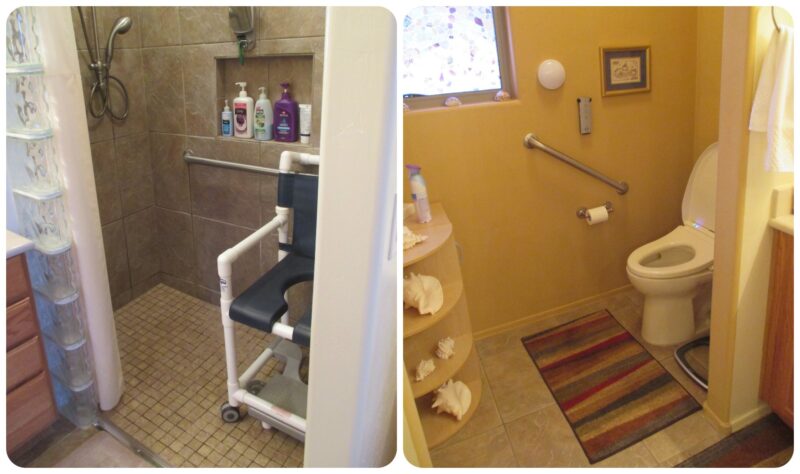These bathroom safety modifications were a great decision
An estimated 80% of falls in the home happen in the bathroom

An old adage says, “Do something today that your future self will thank you for.” Well, I’m in that future now, so today, I’m sending my past self a basket full of thanks. Why? Because every time I walk into our bathroom, I’m grateful. And I believe the modifications my husband and I made to our bathroom during my first year with ALS were among our best decisions.
Ask a real estate professional what the most important room in a house is and they’ll probably say the kitchen or the living room. But ask someone like me who lives with ALS and we’ll likely tell you it’s the bathroom. Among the many challenges of living with ALS are the physical symptoms of muscle stiffness and weakness. I have both and need to use a wheeled walker to steady my balance. That makes having to deal with awkwardly placed bathroom fixtures, along with tight spaces, a mighty frustrating experience.
Did you know that 80% of falls in the home happen in the bathroom? When I learned of that alarming statistic, I knew my ALS puts me in the high-risk category. So, besides making our bathroom a more pleasant experience and convenient for me, safety also became a high priority.
Following is a quick summary of the modifications we made:
A sprinkling of grab bars
Standing in the middle of our bathroom, I asked myself, “If I felt off-balance, where should a grab bar be at the ready to steady me?” Soon, several strategically placed grab bars adorned the walls. Some were horizontal, others vertical, and one near the toilet was even at an angle. My advice is to be generous in the number of bars you install and run through all of your possible movements to choose the perfect placement.
A shower conversion
Originally, our bathroom had a walk-in shower with a glass door that swung open. Our remodeling began by pulling out the prefab shower and adding tile to the back walls and floor. This opened the entrance and eliminated the door and its bottom rim, which I had difficultly stepping over.
Instead of a door, we now have a simple pull-curtain. Other changes included a wall-mounted, hand-held shower head, a recessed area for soap and shampoo bottles, and of course, sturdy grab bars.
We also switched out our standard toilet for an ADA-height bidet model and made sure there was plenty of room to maneuver a rollator to access it.

A renovated bathroom helps keep columnist Dagmar Munn safe while living with ALS. (Photo by Dagmar Munn)
To chair or not to chair?
My husband and I discussed adding a shower chair, but I was resistant to using one. Sure, I had all the excuses: I didn’t need one yet, getting one meant I was giving up, and shower chairs are for old people anyway!
All it took was one instance of me having to shampoo my hair one-handed while my other hand clung to a grab bar and then the scary moment of feeling my bare feet sliding away on the soapy tiles below. That quickly changed my mind, and we promptly ordered a sturdy PVC shower chair.
I discovered that sitting while showering not only gave me full use of both my hands, but also my body felt relaxed and the chair gave me the luxury of time to enjoy taking a shower. Most importantly, I felt safe.
Final thoughts
At the time we began making the modifications to our bathroom, I wondered if it would be worth the expense. Now, 14 years later, I am thankful we did it.
It’s important to adapt my examples and experiences to what is best for you. Your doctor, caregivers, and family are good resources, as is Your ALS Guide, which offers many more helpful suggestions.
I believe we can live well while living with ALS.
Note: ALS News Today is strictly a news and information website about the disease. It does not provide medical advice, diagnosis, or treatment. This content is not intended to be a substitute for professional medical advice, diagnosis, or treatment. Always seek the advice of your physician or other qualified health provider with any questions you may have regarding a medical condition. Never disregard professional medical advice or delay in seeking it because of something you have read on this website. The opinions expressed in this column are not those of ALS News Today or its parent company, BioNews, and are intended to spark discussion about issues pertaining to ALS.








Comments